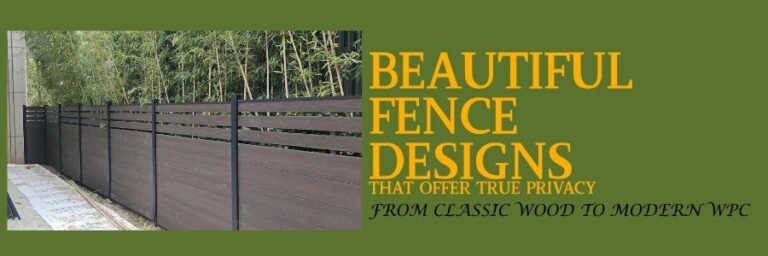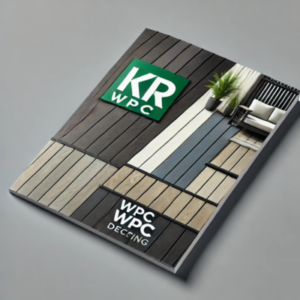Whether you’re planning your first backyard fence or replacing a wobbly run that’s seen better days, post spacing is where the whole project stands or falls—literally. Grab a coffee, pull up a chair, and let’s map it out in plain English.

Introduction: Why Fence Post-Spacing Matters
- The backbone of a strong fence
Every sturdy fence starts with well‑placed posts. Spacing is the rhythm of your fence—set it right, and everything else clicks into place. Set it wrong, and you’ll chase crooked lines, sagging rails, and rattling panels before the season’s over. - Common mistakes homeowners make
Uneven spacing leads to sagging panels, weak alignment, and early damage. I’ve seen folks “eyeball” the distance between posts and then spend the weekend re‑digging holes. Not fun. Not cheap. - How KR WPC fencing enhances post‑spacing reliability
Composite systems (especially WPC paired with aluminum posts and rails) deliver consistent dimensions and stiffer spans, which makes layout simpler and more forgiving. KR WPC’s systems come with matching posts, rails, bases, caps, and clips—so you’re working with components designed to fit together without guesswork.
Running late, the idea still stuck: your fence is only as strong as the spacing between posts.
Understanding the Basics of Fence Post‑Spacing
- What determines the distance between fence posts 1) Fence material
Wood, vinyl, metal, or WPC all flex differently and carry different weights.
2) Fence height
Taller = more wind load. That generally means tighter spacing.
3) Purpose of the fence
Privacy fences handle large solid sails (wind), decorative fences are lighter, and boundary/farm fences can sometimes span wider distances.
Standard ranges for most fences
Here’s a quick cheat sheet you can screenshot:
| Fence Type | Typical Post Spacing | Why It Works |
| Wood picket/panel | 6–8 ft | Balances cost and stiffness; go closer for heavy panels or windy sites. |
| Vinyl/PVC | 6–8 ft | Matches panel widths; closer spacing reduces bowing. |
| Chain link | 8–10 ft | Fabric tension allows wider bays; reduce spacing for tall fences or wind. |
| WPC/composite | 6–8 ft | Panels commonly 6 ft; some systems engineered for 8 ft on-center. |
| Split-rail/rural wire | 8–12 ft | Light loads, rails span farther; brace corners well. |
Two quick examples you can model against:
- KR WPC lists 6‑ft (1.83 m) board and panel dimensions—ideal for 6‑ft post centers.
- Trex’s Seclusions composite system is designed for “8 feet (96 inches) wide on center,” which shows what a reinforced composite system can handle.
Factors That Affect Optimal Post‑Spacing
Installation method 1) Setting posts in concrete vs. ground spikes
Concrete footings, sized correctly, resist racking and frost better than spikes in most residential settings.
2) Using metal post anchors for WPC fencing
KR WPC’s systems use post bases/metal supports that lift the post off ground contact and tie into concrete—great for preventing leaning and moisture problems at the base.
Local climate and soil type 1) Wind zones
Strong winds demand closer post spacing and stiffer rails. Manufacturer wind ratings (for example, composite privacy kits rated to triple‑digit gusts) are a clue—but remember: the taller and more solid the fence, the more the wind tries to tip it.
2) Soil conditions
Sandy or soft soils need deeper footings, potentially larger posts, and sometimes closer spacing to reduce leverage. In frost‑prone climates, posts should extend below the local frost line to reduce heave.
Fence design and weight distribution 1) Horizontal vs. vertical panels
Horizontal runs put more bending stress across the span; many pros tighten spacing by 1–2 ft compared with vertical pickets of the same height.
2) Decorative top rails or heavy panels
Extras like metal top rails, lattice, or thick boards add weight—tighten spacing a notch to keep lines crisp.

How to Measure and Plan Fence Post‑Spacing
- Preparing the layout
1) Mark property boundaries
Use string lines (tight!) or a laser to establish your straight reference. Check setbacks and HOA rules before you break ground.
2) Determine gate locations
Gate openings deserve special attention—plan for wider, heavier gate posts and, often, slightly tighter spacing near gates to control sag. - Calculating post distances
1) Divide the total fence length by your target interval
Adjust so you don’t end up with a weird 2‑foot “orphan” panel at the end.
2) Always start from a corner post
Corners lock in alignment, so build your rhythm off the corner and march down the line.
A simple way to visualize “on center” (OC):
[Post]———96″ OC———[Post]
Measure from the center of one post to the center of the next. For many composite kits, that’s either 72″ (6 ft) or 96″ (8 ft) OC depending on the system. - Common mistakes to avoid
1) Ignoring ground slope
If the grade drops, identical OC spacing can create jagged top lines unless you step or rack panels strategically.
2) Overextending post spacing
Don’t stretch 6‑ft panels to 7 ft “just because it almost reaches.” That’s how you get mid‑span sag and rattling rails.

Pro tip you may have noticed: when spacing by pre‑made panels, always check the actual panel width plus the small clearances the manufacturer calls for. Many WPC panels are right around 1.8 m (about 71″) with a couple of millimeters of expansion room on each side.
Expert Tips for WPC and Composite Fence Post Installation
- Recommended spacing for WPC fence posts
- Ideal distance: 6–8 ft for most modern composite systems. Use 6 ft when you’re installing tall solid‑privacy sections, live in a breezy corridor, or have soft ground. Composite kits designed with reinforced rails (aluminum inserts bottom/top) can run 8 ft on‑center per manufacturer spec.
- Reinforcement and longevity tips
- Use corrosion‑resistant fasteners (stainless or properly coated).
- Seal/raise post bases properly so water can’t pool at the foot. KR WPC’s post supporter (metal base) combined with concrete footing offers a tidy, durable connection.
- Leave the recommended expansion gaps between panels and posts (e.g., KR WPC notes a small allowance for thermal movement) so seasonal shifts don’t translate into bulges or stress.
- Tools and planning essentials
- Must‑haves: string line, level, post‑hole digger or auger, tape, marking paint, gravel, concrete, and a spare battery for your driver (trust me on that).
- Pre‑measure each panel before you set the next post. It’s faster to nudge a hole location now than to re‑dig it later. “Measure twice, dig once” saves weekends—and marriages.
- Why proper spacing extends fence life
- It prevents stress cracks in rails, keeps pickets tight, and preserves visual alignment. Combine correct spacing with proper depth and you’ll feel the difference when the wind kicks up. Trex’s wind‑tested panel kits (with aluminum bottom rails) are a good reminder that structure matters when your fence doubles as a sail.
How deep should the posts be?
You might be wondering, “Is there a simple depth rule I can follow?” Yes—within reason.
- As HGTV puts it: “The general rule of thumb… is one‑third to one‑half of the above‑ground height.” Keep holes about three times the post diameter.
- In frost zones, go to or below the local frost line (check your building department). Many pros will say: at least 24″ deep everywhere, and deeper in cold regions.
And yes, that means a 6‑ft (above‑grade) fence often wants ~30–36″ of post in the ground, plus a gravel base for drainage.
Real‑world spacing scenarios (so you can sanity‑check your plan)
- 6‑ft tall wood privacy fence in a typical suburban backyard
- Spacing: 6–8 ft OC; go 6 ft if your yard is breezy or you’re using heavier panels.
- Depth: ~30–36″ with 12″ diameter footings.
- 6‑ft tall WPC privacy with reinforced rails
- Spacing: 6 ft if you want “brick‑house” rigidity; 8 ft if your system is engineered for it (e.g., Trex Seclusions).
- Notes: Follow the kit’s bracket and aluminum‑rail instructions; use the post base/anchor into concrete where applicable.
- Rural split‑rail or field fence along a long boundary
- Spacing: 8–12 ft depending on rails and bracing; brace ends/corners thoroughly in accordance with agricultural fencing best practices.
Planning math you can copy
Let’s say your back line is 74 feet and you want 6‑ft WPC sections.
- 74 ÷ 6 = 12.33 sections
- Use 12 full bays (12 × 6 = 72 ft), then adjust two bays slightly to absorb the remaining 2 ft evenly—ideally near a corner or gate so it looks intentional.
If you’re working with an 8‑ft composite system:
- 74 ÷ 8 = 9.25
- Plan for 9 bays at 8 ft (72 ft) and one “trimmed” bay near a corner at ~6 ft with matching brackets.
Pro move: always start from a fixed corner or a gate opening so any small adjustments land where they’re least visible.
Why WPC from KR WPC makes spacing easier
- Consistent components, consistent spans
KR WPC’s lineup includes WPC or aluminum posts, post bases, top/bottom rails, covers, and caps, which makes center‑to‑center planning straightforward (no “will this random bracket fit that random post?” drama). You can browse the product lineup and specs here: KR WPC composite fencing. - Typical KR WPC panel lengths
KR WPC lists 6‑ft board lengths, which naturally targets 6‑ft OC spacing for many layouts. If your site is unusually windy or uneven, stay closer. If you need longer runs, look for systems with reinforced rails (some composite systems are engineered for 8‑ft OC). - Install detail that pays you back later
Using the included post base/metal supporter with concrete gives you a clean, raised interface and helps keep posts plumb long‑term—less wicking, less rot risk at the base, better alignment. Add caps to keep water out. Leave tiny expansion gaps at the board‑to‑post interface as instructed.

Conclusion
Picture your finished fence from the street: straight lines, even rhythm, a top rail that looks like it was drawn with a ruler. That look—and the staying power underneath it—comes from nailing your post spacing. As a specialized WPC decking manufacturer that applies its composite expertise to fencing, KR WPC simplifies the job with consistent, modular parts and clear “on-center” targets.
Spend an extra half hour with string, tape, and a calculator today, and you’ll save hours of fixing tomorrow. The result? A fence that stands tall through storms, seasons, and the occasional soccer ball. Looks sharp, too.
FAQ
- Does fence height affect post spacing?
Yes. Taller fences catch more wind, so reduce spacing (e.g., from 8 ft down to 6 ft) as height and panel weight increase. Wind‑rated composite systems help, but physics still wins. - How deep should fence posts be set in the ground?
Follow the “one‑third to one‑half of above‑grade height” rule of thumb; below frost line where applicable. For a 6‑ft fence, that’s often ~30–36″ plus a gravel base. - What is the maximum distance between fence posts?
For most residential wood/vinyl, 8 ft is a practical max; many composite systems are specifically engineered for 8 ft on‑center. Panels that are 6 ft wide should not be stretched beyond that. - What tools help ensure accurate post spacing during installation?
A tight mason’s string line, tape or measuring wheel, line level or laser, post‑hole digger/auger, stakes/flags, and a sharp pencil. For panel systems, pre‑measure the exact panel widths (including any expansion clearance) before setting each post. - Should I use concrete for all fence posts?
In most residential privacy fences—yes. Concrete footings sized to the post and local soil keep posts plumb and resist frost heave. Use metal post bases when your system provides them. In rural wire fences, spacing can be wider and posts may be tamped rather than set in concrete depending on design and soil.








